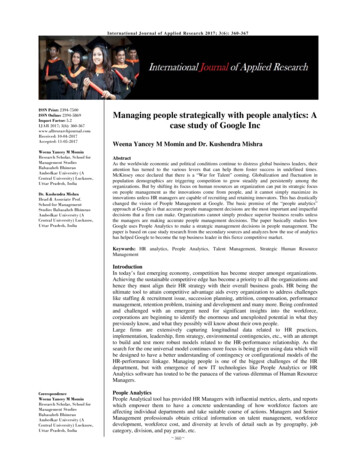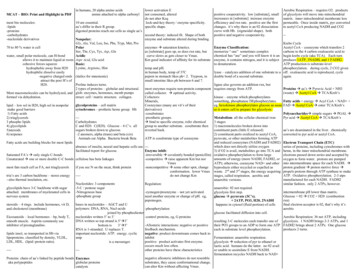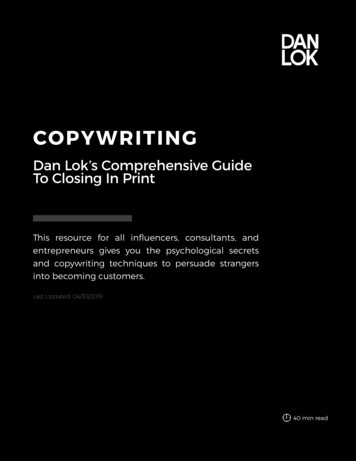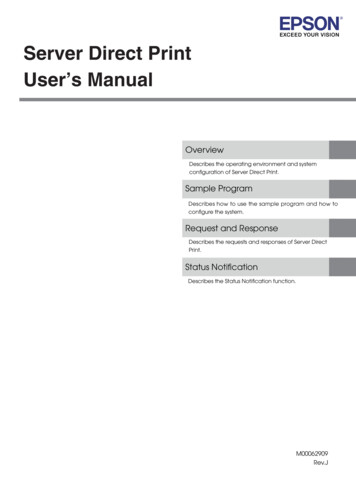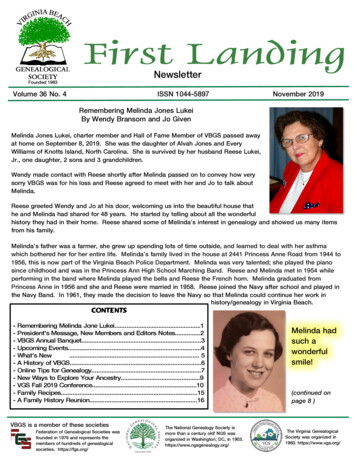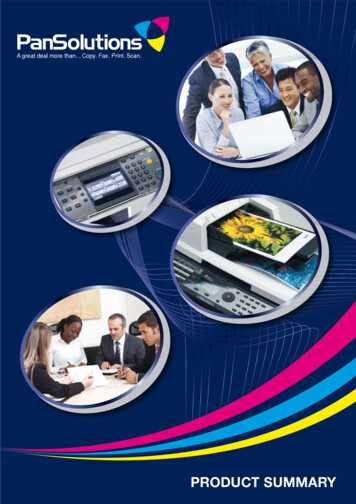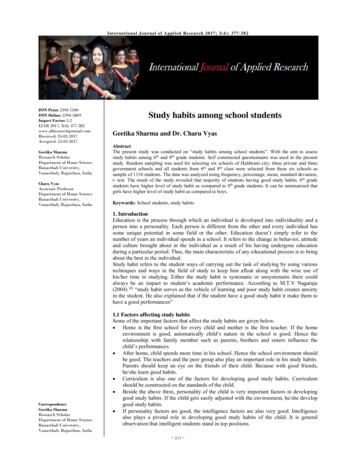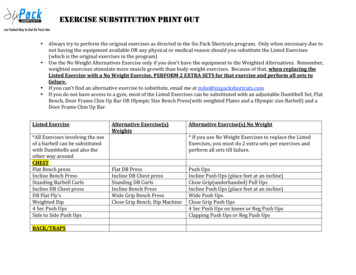
Transcription
POST PRINT of the PAPER:Cannas, V., Pero, M., Pozzi, R., Rossi, T. (2018) Complexity reduction and kaizenevents to balance manual assembly lines: an application in the field, InternationalJournal of Production Research, Vol. 56, No. 11, pp. 3914-3931Link to the 81
Complexity reduction and kaizen events to balance manual assemblylines: an application in the fieldCannas, V., Pero, M., Pozzi, R., Rossi, T. (2018)Notwithstanding the existence of a broad research base on assembly line balancing (ALB),companies do not use the mathematical approaches developed in the literature to configureassembly lines. This article aims to fill the gap between research and application by presentingand testing in a real industrial context a methodology based on complexity reduction and kaizenevents. First, the methodology supports reducing the complexity that affects real-life assemblysystems in terms of the variety of, e.g., finished products, materials and parts. Next, themethodology proposes the conduction of kaizen events by using lean manufacturing tools, suchas process analysis, time observation, waste identification, workstation standard documents, andyamazumi charts. The methodology is successfully applied to a case study that describes its usein the confectionery process for a major chocolatier company along with the results of theapplication. The main contribution of this paper consists in presenting a method to manage theline balancing activity within everyday industrial realities, helping practitioners to improve andmaintain the performance over time.Keywords: assembly line balancing; lean manufacturing; kaizen; yamazumi chart;standardization1. IntroductionAn assembly line is a set of workstations positioned in a definite order and connected bytransport mechanisms (e.g., conveyors) (Saif, 2014). Materials pass through workstationswhere different tasks are performed, following specific precedence relationships toassemble the final product (Baybars, 1986).Assembly line design and balancing strongly affect manufacturing process timesand costs (Rashid et al., 2012). Assembly line design encompasses decisions about thenumber of workstations and type of task to perform in each station. Assembly linebalancing (ALB) aims to assign the tasks to the workstations so that workloads are asequal as possible (Bentaha et al., 2015), thus minimising workstation idle time (Saif,2014) and buffers among them and improving effective utilisation of facilities(Sivasankaran and Shahabudeen, 2014).Notwithstanding the existence of a broad research base on ALB (Battaïa andDolgui, 2013), companies do not use mathematical approaches developed in the literatureto configure assembly lines (Boysen et al. 2007) for several reasons:2
The methods developed in the literature still cannot capture all complexities ofreal-life problems in terms of products, components, materials, and operationsvariety (Battaïa and Dolgui, 2013); Researchers struggle at transferring the scientific knowledge to practitioners(Boysen et al., 2007). So far, few attempts have been made to provide help tomanagers in determining which model to use in their special assembly system(Boysen et al., 2008); The application context changes subject to both internalities, e.g., operation times,resource availabilities (Hazir and Dolgui, 2013), and externalities, e.g., marketdemands, product variety. Therefore, it is often not easy to assure the retention ofresults over time provided by mathematical approaches; The articles dealing with ALB are mainly concerned with the mathematicalmodelling of the problem and less concerned with how to apply the model in thereal world. Boysen et al. (2008) noted that only 5% of articles found in the reviewsby Scholl and Becker (2006), Becker and Scholl (2006), and Boysen et al. (2007),explicitly address line balancing of real assembly systems.Kaizen Assembly might help to overcome this gap. Ortiz (2006) proposed solvingthe ALB problem by performing kaizen events directly on the assembly lines. Kaizenevents are structured projects in which dedicated cross-functional teams apply leanmanufacturing tools (e.g. process analysis, time observation, waste identification,workstations standard documents, yamazumi charts, etc.) to a specific area, focusing ona continuous improvement (i.e., kaizen) mind-set (Cannas et al., 2016). Leanmanufacturing (LM) has been widely discussed in the literature and applied in companies(Jasti and Kodali, 2015). However, to our knowledge, few examples of applications ofLM tools to balance assembly lines may be found in the literature. Talip et al. (2011)propose a method that combines yamazumi and King’s algorithm to redesign the layoutof a fishery factory and balance the workload on the newly defined manufacturing cells.Despite the relevance of yamazumi charts in improving assembly processes and theimportance of clustering algorithms, the proposed methods do not seem sustainable inhigh variety contexts, such as actual ones where both the number of products to beassembled and the rate of new product introduction are high. In fact, performing kaizenevents for every product and redesigning the layout of the manufacturing plant every time3
a new product is launched would require too much time and too many investments.Therefore, the following research question emerges: “How can companies perform ALBin high variety contexts in an efficient and effective way that can support maintaining theperformance over time?”.The present work aims to answer this question by filling the gap betweenacademic literature and practical applications. To this end, we propose a two-stepmethodology for ALB. The first step is aimed at reducing the real-life complexity in termsof the variety of finished products, materials and components, which must be handled bythe assembly line. The second step allows to perform the balancing of the assembly line.It does not apply mathematical balancing models but organisational tools based on thekaizen event concept. This since, on the one hand, as previously mentioned and moredeeply discussed in the literature review, ALB mathematical models are not so used inreal-life contexts and, on the other hand, the use of kaizen-based organisational tools letspractitioners involved in the process better understand and more independently adapt theline balancing over time. The methodology has been successfully applied in the Italianplant of a chocolatier and confectionery company.The paper is structured as follows: in section 2, a review of literature related toALB is performed; in section 3, the methodology is introduced; then, in section 4, theapplication to the case study is presented; in section 5, the obtained results are discussed;finally, in section 6, the main conclusions of the study are presented.2.Literature review2.1 Assembly line balancingA recent study performed by Battaïa, and Dolgui, (2013) reviewed and analysed therecent literature related to the ALB problems (ALBPs), classifying the main solvingmethods and underling the current gaps and recent trends in the literature. They definedthe ALBP as complex combinatorial problems, classified as NP-hard. For this reason, thesolution methods mostly applied in the literature, according to Battaïa, and Dolgui (2013),consist in the application of the mathematical models mainly used for the combinatorialoptimisation: (i) the exact methods, which are suitable to search for the optimal solution,among a set of finite possible solutions, when the complexity of the problem is not toohigh and the time to generate the solution is feasible with respect to the time available;(ii) the approximate methods, which are often better for solving large-scale ALBPs: they4
do not assure optimality such as exact methods do, but they can provide feasible resultsin adequate time.In the following subsections, the characteristics and the main problems in the applicationof these methods to real complex industrial realities are analysed in-depth.2.1.1 Exact methodsExact methods include different models such as mixed integer programs, general solversuseful for describing and understanding different assembly lines, and branch and boundand dynamic programming, which are original dedicated methods helpful in dividing theoptimisation problem into sub-problems. These methods are particularly effective onlywith small-scale applications related to a restricted number of tasks (Battaïa, and Dolgui,2013). Given the extremely high computational complexity for problems of significantsize, such as real-world problems, an optimal solution requires extremely long solvingtimes with a consequent low practical relevance (Pachghare and Dalu, 2014).Scholl and Boysen (2009), for example, developed a branch and bound procedure(i.e., Absalom) for solving ALBPs. They assessed the method through a computationalexperiment based on a data-set proposed in the literature: it showed good results andoptimality if applied to small- and medium-sized problems; however, for larger problems,the deviation from optimality might become high. Additionally, Kellegöz and Toklu(2012) applied a branch and bound procedure (i.e., Jumper) to solve ALBPs and evaluatedit by means of an experimental study based on a benchmark problem proposed in theliterature for simple ALBPs; the results revealed that even if this exact method is betterthan previous methods in terms of solving time, it does not perform well in findingfeasible solutions when applied to large problems. Recently, Roshani and Giglio (2016)proposed a mixed integer mathematical program to solve ALBPs, stating, that sinceALBPs are NP-hard, these methods can find an optimal solution in reasonable time onlywith small-sized problems. Therefore, they additionally proposed two approximatemethods to address larger ALBPs.2.1.2 Approximate methodsApproximate methods are classified as heuristic and metaheuristic. According toPachghare and Dalu (2014) and Battaïa, and Dolgui (2013), heuristic methods are based5
on assigning tasks through the application of the greedy approach or priority rules (e.g.,maximum task time, minimum earliest, etc.). These methods consist of performingrandom iterations to provide solutions, the best of which is retained. The number ofiterations defines the time and optimality of the solution: single-pass heuristics (i.e., oneiteration) provide quick results even with large-scale problems, whereas multi-passheuristics allow the analysts to find different and optimal results at each step, and theycontinue to iterate until the solutions become stable. The heuristic methods are useful forimproving exact method solutions or for providing a local optimum of intermediatesolutions, which needs to be included in metaheuristic methods. Metaheuristic methodstry to cope with the heuristic limitations, providing an initial solution and then moving toan improved neighbour solution without stopping when a worse solution is found to avoida premature end of the iterations (Pachghare and Dalu, 2014).Among the approximate methods, genetic algorithms (GAs), simulated annealing(SA) and ant colony optimisation (ACO) are applied most often (Sivasankaran andShahabudeen, 2014). Even if these methods are faster than exact methods in solving largeALBPs, most studies in the literature, according to Battaïa, and Dolgui (2013), addressedsimplified ALBPs based on the following assumptions: a single serial assembly line isrelated to one homogeneous product, characterised by fixed cycle times and deterministicoperation times and composed of equally set workstations (Scholl and Becker, 2006). Inaddition, specific literature reviews related to approximate methods recognised thescarcity of applications to real-world ALBPs. For example, Tasan and Tunali (2008) intheir review of GAs applied to ALBPs, stated that GAs still have not been shown toeffectively solve complex problems. They found a lack of studies in this field addressedto real-world ALBPs and an absence of tests to demonstrate the performance of GAs topractitioners with realistic results. Additionally, Rashid et al. (2012) in their review ofsoft computing approaches such as GA and ACO, found a gap in the literature concerningthe application of these methods to complex ALBPs. Moreover, they expressed a needfor making the application of these methods closer to the real world but also emphasisedthat this increases the complexity and computational costs.Accordingly, recent studies are providing innovative methods, which consider asmuch as possible the real-life conditions (i.e., complexity and variability). Nevertheless,few authors have applied their innovative approximate methods to real case studies as,for example, Polat et al. (2016). They developed a metaheuristic methodology based on6
a variable neighbourhood search that considers the real-world variability of task timesdepending on worker skills. The authors applied the developed methodology to a real casestudy to test it in an industrial context, showing that their algorithm helps in improvingperformance when they depend also on worker skills. However, the authors recognisedthat the algorithm still does not consider other important real-world variants such as jobrotation, collaboration between workers, etc. that should be included in future studies.Most studies still test their innovative approximate methods with ALBP samplestaken from the literature. For example, the study developed by Roshani and Giglio (2016)proposed two innovative metaheuristic approaches, based on SA, to solve ALBPscharacterised by parallel working places in each workstation. They first proposed amathematical solution to this type of ALBP, applying SA to more realistic and complexALBPs; however, they did not assess the method with a real case study but tested it on aset of problems taken from the literature. In addition, Delice et al. (2016), developed anew GA approach that considers conditions characterising real-world ALBPs such as thestochastic task time; however, they also tested the method with a sample taken from theliterature without considering a real case study.In conclusion, efforts are still needed to reduce the gap in the literature betweenthe practical and theoretical world of ALBPs, to improve the applicability ofmathematical models to large and complex ALBPs in real industrial cases and to make itpossible to maintain improvements over time.2.2 Kaizen assemblyThe concept of “kaizen”, i.e. continuous improvement, was introduced by Imai(1986) to define a business strategy that “involves everyone in an organisation workingtogether to make improvements without large capital investments”. Later, Harmon andPeterson (1990) described the continuous improvement as the key to become a worldclass manufacturer. Moreover, kaizen events can generate positive changes “in businessresults and human resource outcomes” (Glover et al. 2011). For this reasons, the kaizenconcept and its empirical applications have been have been analysed in the literature.Hyer and Wemmerlov (2002) defined continuous improvement as fundamentalfor manufacturing philosophies to increase performance of a specific variable withoutnegatively affecting the others important ones. They emphasised the concept of “kaizenblitzes”, i.e. intense improvement activities based on teamwork, which affect the7
employees’ motivations and job satisfaction thanks to the increasing interaction andmutual dependency with the group. The kaizen blitzes make possible to effectively findproblems, search for solutions, apply them and control the results over time. Theyexplained how to build an improvement culture within the company by prescribingactions such as making improvement an expectation, creating improvement teams andbeing open to new ideas that come from the workforce involved in the process. This workprovides good insights related to the kaizen application and useful guidelines, but doesnot provide in-depth analysis related to empirical applications.Hamel (2010) defined kaizen events as drivers for applying LM tools and reducewastes. His work provided guidelines to practitioners on how to apply kaizen within acompany and how to conduct kaizen events. The main key factors identified were thegood definition of the standard work approach, the identification of the strategy andvalue-stream driving the events, the presence of an effective lean transformation leaderand, finally, the application of an employee-driven approach. Unfortunately, noapplications of the techniques and practices well outlined by the author to real industrialcases are provided.Regarding the application of the kaizen to the ALBPs, an approach was proposedby Ortiz (2006). He introduced the “kaizen assembly”: a methodology to design andbalance the assembly lines performing kaizen events directly on the assembly lines. Ortiz(2006) described in detail an industrial application of kaizen assembly to a manualassembly line, the Electric Bike line, and highlighted the best methods to design andbalance the assembly lines by means of kaizen events. According to this study, in solvingALBPs, the following steps are needed: (i) performance of a rigorous time and motionstudy, (ii) definition of volume requirements and effective hours of the line, andconsequently, (iii) calculation of takt-time, namely, the line pace to consider for balancingworkstations. Studying time and motion helps to identify and eliminate non-value addedactivities, improving the line flow. Takt-time definition permits balancing work andmaking the cycle times of each workstation equally distributed and aligned to the linepace so that the operators do not wait excessively or reach overcapacity. In addition, workcontents can be well distributed with the help of operators and the kaizen team, defininghow to split work contents according to the takt-time without decreasing product quality.Finally, considering the type of materials moving along the line and the takt-time, the linecan be redesigned to define the right number and position of workstations within the8
assembly line. In conclusion, Ortiz (2006) demonstrated the effectiveness of kaizenevents for solving ALBPs, identifying the low implementation costs and exploitation ofthe value and talent of the existing workforce as one of the main benefits of kaizen events.In 2009, an additional work was developed by Ortiz to define guidelines toimplement kaizen and kaizen events in a company, based on his empirical experience.He, first, defined the steps needed for the application of LM tools such as 5S and standardwork during kaizen events. The study suggests to first compute the effective times andthe volume requirements, to well define the required takt-time to respect for satisfyingthe customer requirements. Then, the process analysis is suggested, by means of LMtools, such as time and motions study. Finally, the assembly balancing can be reachedconsidering time, work contents, and inventory. Ortiz (2009) described also a specificcase study where kaizen events have been successfully applied in a company mainlymanual-assembly based. He demonstrated that the main benefits from kaizen eventsapplication are both measurable and non-measurable: on the one hand, a better applicationof LM, reaching good results in terms of performance and customer satisfaction; and onthe other hand, spread of a solid kaizen concept within the organisation. Nevertheless, thecase study application was mostly related to 5S kaizen events, while the standard workkaizen events to reach a good line balancing have not been considered in this application.Recent studies have further developed the concept. However, despite showing theability of kaizen assembly to solve ALBPs, in literature only few works present realapplications of the method and provide the supporting tools for a correct implementation,such as examples of standard work sheets. For example, Álvarez et al. (2009) defined amethodology to redesign and balance assembly lines based on the kaizen concept andapplied it to a real case study, focusing their study on a specific products family, aninjection valve. Their work demonstrated how this approach can quickly reach good anddurable results in real industrial case studies. The main results reached with theapplication of the kaizen concept to assembly lines were: elimination of non-value-addedtimes, improvement of material flow, cycle time reduction, inventory reduction along theline, and an increase of flexibility.Then, Prashar (2014) addressed the application of kaizen events to redesign theassembly line of a company. He stated that application of LM tools could loseeffectiveness unless supported by kaizen concept. Thus, he conducted qualitativeinterpretative research to study how an Indian company improved the assembly process9
of the Column Type Electric Power Steering by applying kaizen events. This studyreached several tangible results such as the reduction of inventory levels, required storagespace, the distance travelled by material, and the defection rate; intangible results werealso reached such as the improvement of the kaizen team’s ability to implement the kaizenconcept, maintaining improvements over time and quickly replicating them in otherassembly lines.Ham and Park (2014) proposed a framework (i.e. a five-level decompositionmodel) for the application of continuous improvement to a manned assembly line. Theystated that this approach is based mainly on two activities: the “assembly work processimprovement”, related to the efficiency of the workers and workstations along the line,and the “improvement of line balancing efficiency”, related to the workloadsoptimisation. This work is mainly focused on the process design looking at both macro(i.e. system) and micro (i.e. motion) aspects, by analysing both the workstation and theline. The framework was also successfully applied to a real industrial case study,providing performance improvement and minimising inefficiencies, but no details aboutthe considered product/line are given.In conclusion, the effectiveness of kaizen events applied to ALBPs has beenproven in the literature. Nevertheless, theoretical and empirical work is still needed toexplore the “kaizen assembly”. The lack of studies related to the kaizen concept has beenunderlined by the in-depth literature review by Suárez-Barraza et al. (2011). They foundout that the definition of kaizen and its application within companies is quite confusedand inconsistent in the literature. The ambiguity makes complex for practitioners toimplement kaizen approaches in the real world. For this reason, there is a need for studiesthat analyse the main key factors for kaizen successful application in companies withdifferent size (big, medium, and small) and in different areas (manufacturing and service).Finally, as shown in the above literature review about kaizen assembly, this concept hasbeen few covered in the literature and more empirical research is needed to defineeffective methodologies and tools for applying the kaizen concept, solving real ALBPs,and maintaining good results in the long term. Moreover, it is worth underlying that noneof the revised studies has applied kaizen in cases dealing with numerous differentproducts, overlooking such an issue.10
3. Research objective and methodologyThe present work proposes a methodology with a twofold objective: (i) ease the ALBdealing with a large number of parts; and (ii) allow practitioners to sustain assembly lineperformance improvement over time.The methodology is structured in two phases: (i) complexity reduction to reducethe problem size derived by the proliferation of product and part variants by means ofclustering and the definition of macro-cycles, i.e., the set of tasks and the estimatedassembly time required by one or more end-items; and (ii) kaizen events, for assemblyline balance and performance improvement and enhancing assembly activities by meansof LM tools. Kaizen events, in fact, are proven to increase manufacturing performanceand overcome the limitations of other methodologies, such as the difficulties intransferring knowledge to practitioners. They assure the retention of line balancing resultsover time, and address real assembly systems balancing issues. Figure 1 depicts themethodology outline that will be discussed in the following. The complexity reductionphase is preparatory to kaizen events to bound the number of kaizen events to beperformed for an efficient enhancement of assembly line performance. In fact,considering macro-cycles allows for the simultaneous improvement of assemblyperformance for all end-items assigned to the same cluster through standardisation andline balancing of only one end-item assigned to that macro-cycle. In addition, in case ofnew end-items, the identification of the corresponding macro-cycle leads to immediateidentification of an efficient and effective line configuration. 3.1 Complexity reduction11
Figure 13.1.1 BackgroundThe here-proposed methodology aims to improve assembly line performance in a contextcharacterised by complexity. Saeed and Young (1998) define complexity as the “systemiceffect that numerous products, customers, markets, processes, parts, and organisationalentities have on activities, overhead structures, and information flows”. Severalmethodologies support the analysis of complexity in manufacturing (Efthymiou et al.2016).Complexity can be managed and reduced by applying different strategies both atthe product level, i.e., component commonality, product modularity, platforms,component configurations and product variations, and at the process level, i.e.,component families/cell manufacturing, process modularity, process commonality anddelayed differentiation (Bednar and Modrak, 2014; Brun and Pero, 2012).Clustering is one of the common methods used to reduce complexity by groupingelements that present some similarities, thus reducing the number of problem elements,12
and it is applied in many strategies to reduce or manage complexity. Clustering is at thebasis of the application of group technology and, therefore, cell manufacturing. Bhaskarand Narendran (1996) apply group technology to group printed circuit boards andcomponents based on an ad hoc measure of similarity. Gonçalves and Resende (2004)combine a local search heuristic with a genetic algorithm to group product families andmachines into cells. Al-Araidah et al. (2007) propose a clustering step to reduce thecomplexity of the block layout problem. They partition work centres into clusters basedon flow intensity. In contrast, Agrawal et al. (2011) apply the ant colony optimisationapproach to parts and machines, grouping problems taken from the literature.3.1.2 Complexity reduction phase descriptionThe complexity reduction phase presented in the following section contains threeconsecutive steps: (i) clustering of parts; (ii) macro-cycles definition; and (iii)representative products selection.Clustering of partsThe ‘clustering of parts’ addresses the problem of partitioning parts starting from sets ofparts. From an assembly perspective, the distinction/equivalence between parts should bebased on tasks to be performed and their cycle time. As details on the tasks and cycletimes involved in the assembly of parts is usually neither formalised nor recorded indatabases, a clustering algorithm should be performed involving a team with practicalknowledge of the assembly activities involved with the parts, end-items managed by theplant, their bill of materials (BoMs) and the related assembly performance. Figure 2outlines how to conduct the ‘clustering of parts’ step. Given the end-items assembled bythe line and the set of parts (i) needed for their assembly (Figure 2a), the tasks they require(Figure 2b) and the cycle time they involve are compared to each other (Figure 2c). Eachpart requires one task. Whether a part (i I) in the BoMs requires a task equivalent (bothtask and cycle time) to a previously analysed part (j i, j I), i belongs to an alreadydefined cluster (ci cj C, C C1, , CN); otherwise, a new cluster is defined (Figure 2c).A cluster of parts is characterised by the combination of a task and the correspondingcycle times (Figure 2d). As all parts assembled by the line are analysed and belong to a13
cluster, the macro-cycles can be defined (Figure 2e).Figure 2Macro-cycle definitionA ‘macro-cycle’ identifies the set of tasks and the estimated assembly timerequired by one or more end-items. It is represented by a sequence of cluster numbers(ascending order) assigned to the parts listed in the BoM of the considered end-items. Forany end-item assembled by the line, the sequence is obtained through the substitution ofevery part-ID in the BoM with the corresponding cluster number. As the same tasks andtime (i.e., cluster numbers) are involved by more end-items, the same ‘macro-cycle’ isassigned to more end-items.Representative products selectionThe last step of the complexity-reduction phase concerns the identification of the mostrepresentative ‘macro-cycles’ sample to be studied for line performance improvement.Identification is based on a modification of the product quantity analysis (PQA), aclassical approach for product mix segmentation (Braglia et al. 2006). According to theliterature, the underlying logic of PQA is that high volume products are responsible for14
most non-value-added costs. The same logic is proposed for assembly lines to boostoverall performance of the line, improving high-volume ‘macro-cycles’. Themethodology considers the planned working hours (given by the sum of the plannedworking hours of every assembled end-item that is assigned the same ‘macro-cycle’)instead of the quantity, as big differences in time consumption of the assembly lineavailability by end-items could occur. This method proposes to display the ‘macro-cycle’mix
assembly lines. This article aims to fill the gap between research and application by presenting and testing in a real industrial context a methodology based on complexity reduction and kaizen events. First, the methodology supports reducing the co


